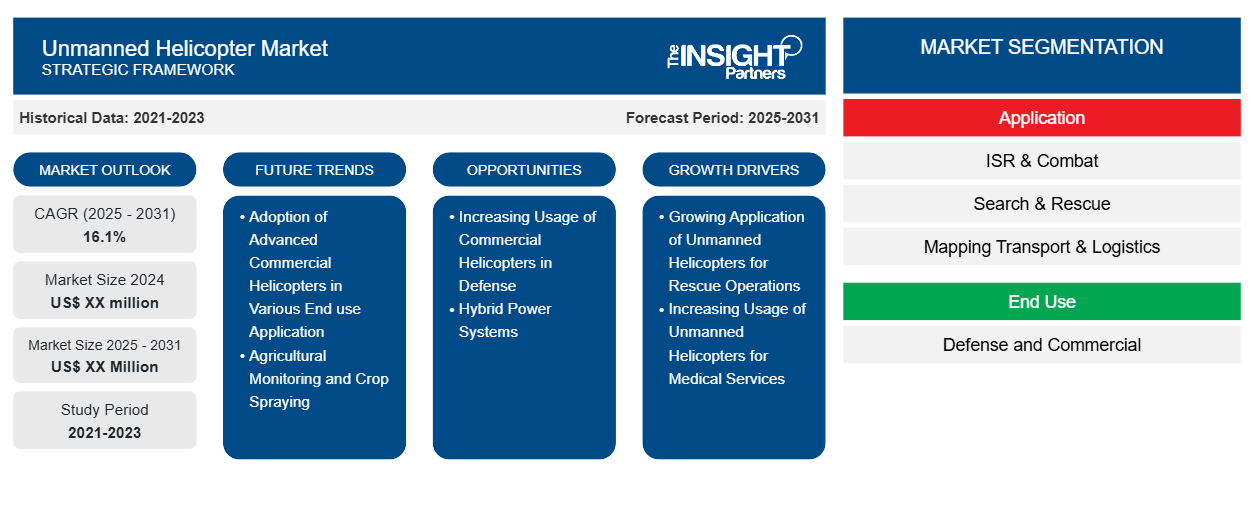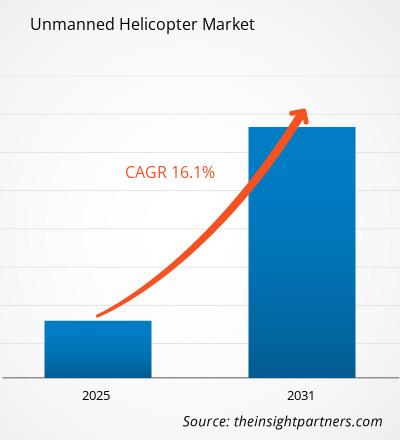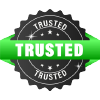The Unmanned Helicopter Market is expected to register a CAGR of 16.1% from 2025 to 2031, with a market size expanding from US$ XX million in 2024 to US$ XX Million by 2031.
The report is segmented by Application (ISR & Combat, Search & Rescue, Mapping Transport & Logistics, and Others), End Use (Defense and Commercial). The global analysis is further broken-down at regional level and major countries. The Report Offers the Value in USD for the above analysis and segments.
Purpose of the Report
The report Unmanned Helicopter Market by The Insight Partners aims to describe the present landscape and future growth, top driving factors, challenges, and opportunities. This will provide insights to various business stakeholders, such as:
- Technology Providers/Manufacturers: To understand the evolving market dynamics and know the potential growth opportunities, enabling them to make informed strategic decisions.
- Investors: To conduct a comprehensive trend analysis regarding the market growth rate, market financial projections, and opportunities that exist across the value chain.
- Regulatory bodies: To regulate policies and police activities in the market with the aim of minimizing abuse, preserving investor trust and confidence, and upholding the integrity and stability of the market.
Unmanned Helicopter Market Segmentation
Application
- ISR & Combat
- Search & Rescue
- Mapping Transport & Logistics
- Others
End Use
- Defense and Commercial
You will get customization on any report - free of charge - including parts of this report, or country-level analysis, Excel Data pack, as well as avail great offers and discounts for start-ups & universities
Unmanned Helicopter Market: Strategic Insights

-
Get Top Key Market Trends of this report.This FREE sample will include data analysis, ranging from market trends to estimates and forecasts.
Unmanned Helicopter Market Growth Drivers
- Growing Application of Unmanned Helicopters for Rescue Operations: The growing proliferation of unmanned helicopters for the rescue purpose and helping in any casualty situation is anticipated to drive the growth of unmanned helicopters market. The rising number of casualty situations is also boosting the demand for unmanned helicopters for search and rescue operations across the globe.
- Increasing Usage of Unmanned Helicopters for Medical Services: The growing usage of unmanned helicopters for the medical services is also one of the drivers for the unmanned helicopter market across the globe. The rising advancement in the medical sector is anticipated to fuel the growth of unmanned helicopters globally.
Unmanned Helicopter Market Future Trends
- Adoption of Advanced Commercial Helicopters in Various End use Application : The growing proliferation of commercial unmanned helicopters for monitoring any casualty situation such as flood, earthquake, or fire outbreak is also acting as a major driver for the market. The rescue operators primarily leverage unmanned helicopters for surveillance and monitoring purposes and to get an aerial view of the overall situation, which helps in making major decisions regarding the ways to initiate rescue operations. Additionally, the rising application of commercial unmanned helicopters in parcel delivery, owing to the rising proliferation of the retail and e-commerce sector, is also having a positive impact on the unmanned helicopter market globally.
- Agricultural Monitoring and Crop Spraying: The agricultural sector presents a growing opportunity for unmanned helicopters. They can be used for crop monitoring, aerial imaging, and precision spraying of pesticides or fertilizers, improving efficiency and yield while minimizing environmental impact through targeted applications.
Unmanned Helicopter Market Opportunities
- Increasing Usage of Commercial Helicopters in Defense: The unmanned helicopters are useful for transporting and delivering required weapons, medicines and other needed things to the military forces in remote locations. In the time of need, the growing proliferation of unmanned helicopters are anticipated to play a major role which is projected to drive the growth of unmanned helicopter market over the forecast period.
- Hybrid Power Systems: The integration of hybrid power systems in unmanned helicopters is gaining momentum, combining electric and conventional engines for enhanced endurance, reduced fuel consumption, and lower emissions. This trend is making these helicopters more viable for extended missions in remote or environmentally sensitive areas.
Unmanned Helicopter Market Regional Insights
The regional trends and factors influencing the Unmanned Helicopter Market throughout the forecast period have been thoroughly explained by the analysts at The Insight Partners. This section also discusses Unmanned Helicopter Market segments and geography across North America, Europe, Asia Pacific, Middle East and Africa, and South and Central America.
Unmanned Helicopter Market Report Scope
| Report Attribute | Details |
|---|---|
| Market size in 2024 | US$ XX million |
| Market Size by 2031 | US$ XX Million |
| Global CAGR (2025 - 2031) | 16.1% |
| Historical Data | 2021-2023 |
| Forecast period | 2025-2031 |
| Segments Covered |
By Application
|
| Regions and Countries Covered |
North America
|
| Market leaders and key company profiles |
|
Unmanned Helicopter Market Players Density: Understanding Its Impact on Business Dynamics
The Unmanned Helicopter Market is growing rapidly, driven by increasing end-user demand due to factors such as evolving consumer preferences, technological advancements, and greater awareness of the product's benefits. As demand rises, businesses are expanding their offerings, innovating to meet consumer needs, and capitalizing on emerging trends, which further fuels market growth.

- Get the Unmanned Helicopter Market top key players overview
Key Selling Points
- Comprehensive Coverage: The report comprehensively covers the analysis of products, services, types, and end users of the Unmanned Helicopter Market, providing a holistic landscape.
- Expert Analysis: The report is compiled based on the in-depth understanding of industry experts and analysts.
- Up-to-date Information: The report assures business relevance due to its coverage of recent information and data trends.
- Customization Options: This report can be customized to cater to specific client requirements and suit the business strategies aptly.
The research report on the Unmanned Helicopter Market can, therefore, help spearhead the trail of decoding and understanding the industry scenario and growth prospects. Although there can be a few valid concerns, the overall benefits of this report tend to outweigh the disadvantages.
Frequently Asked Questions
What are the options available for the customization of this report?
What are the deliverable formats of the Unmanned Helicopter Market report?
Which are the leading players operating in the Unmanned Helicopter Market
What is the future trend of the Unmanned Helicopter Market?
What is the expected CAGR of the Unmanned Helicopter Market?
What are the driving factors impacting the global Unmanned Helicopter Market?
- Historical Analysis (2 Years), Base Year, Forecast (7 Years) with CAGR
- PEST and SWOT Analysis
- Market Size Value / Volume - Global, Regional, Country
- Industry and Competitive Landscape
- Excel Dataset
Recent Reports
Testimonials
Reason to Buy
- Informed Decision-Making
- Understanding Market Dynamics
- Competitive Analysis
- Identifying Emerging Markets
- Customer Insights
- Market Forecasts
- Risk Mitigation
- Boosting Operational Efficiency
- Strategic Planning
- Investment Justification
- Tracking Industry Innovations
- Aligning with Regulatory Trends





















 Get Free Sample For
Get Free Sample For